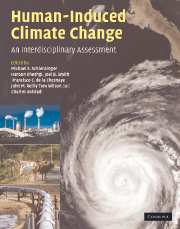Book contents
- Frontmatter
- Contents
- List of contributors
- Preface
- Part I Climate system science
- 1 The concept of climate sensitivity: history and development
- 2 Effect of black carbon on mid-troposphere and surface temperature trends
- 3 Evaluating the impacts of carbonaceous aerosols on clouds and climate
- 4 Probabilistic estimates of climate change: methods, assumptions and examples
- 5 The potential response of historical terrestrial carbon storage to changes in land use, atmospheric CO2, and climate
- 6 The albedo climate impacts of biomass and carbon plantations compared with the CO2 impact
- 7 Overshoot pathways to CO2 stabilization in a multi-gas context
- 8 Effects of air pollution control on climate: results from an integrated global system model
- Part II Impacts and adaptation
- Part III Mitigation of greenhouse gases
- Part IV Policy design and decisionmaking under uncertainty
- Index
- Plate section
- References
4 - Probabilistic estimates of climate change: methods, assumptions and examples
from Part I - Climate system science
Published online by Cambridge University Press: 06 December 2010
- Frontmatter
- Contents
- List of contributors
- Preface
- Part I Climate system science
- 1 The concept of climate sensitivity: history and development
- 2 Effect of black carbon on mid-troposphere and surface temperature trends
- 3 Evaluating the impacts of carbonaceous aerosols on clouds and climate
- 4 Probabilistic estimates of climate change: methods, assumptions and examples
- 5 The potential response of historical terrestrial carbon storage to changes in land use, atmospheric CO2, and climate
- 6 The albedo climate impacts of biomass and carbon plantations compared with the CO2 impact
- 7 Overshoot pathways to CO2 stabilization in a multi-gas context
- 8 Effects of air pollution control on climate: results from an integrated global system model
- Part II Impacts and adaptation
- Part III Mitigation of greenhouse gases
- Part IV Policy design and decisionmaking under uncertainty
- Index
- Plate section
- References
Summary
Introduction to approaches to estimating future climate change
An important approach to assessment of the risks of climate change relies on estimates of future climate based on a variety of methods including: simulation of the climate system; analysis of the sensitivity of climate system simulations to model parameters, parameterizations and models of climate system; and model-based statistical estimation constrained by a variety of historical data. The results of each of these methods are contingent on assumptions. Increasingly sophisticated approaches are being applied, and the implications, or even enumeration, of assumptions is becoming increasingly complex. This chapter gives an overview of the progression of methods used to estimate change in the future climate system and the climate sensitivity parameter. Model-based statistical estimation has the potential of synthesizing information from emerging climate data with models of the climate system to arrive at probabilistic estimates, provided all important uncertain factors can be addressed. A catalog of uncertain factors is proposed including consideration of their importance in affecting climate change estimates. Addressing and accounting for factors in the catalog, beginning with the most important and tractable, is suggested as an orderly way of improving estimates of future climate change.
A variety of methods have been used to generate projections or estimates. The simulations of state-of-the-art models discussed in Section 4.2 are often used as scenarios (plausible representations) of how climate might change in the future (Mearns et al., 2001).
- Type
- Chapter
- Information
- Human-Induced Climate ChangeAn Interdisciplinary Assessment, pp. 49 - 61Publisher: Cambridge University PressPrint publication year: 2007



